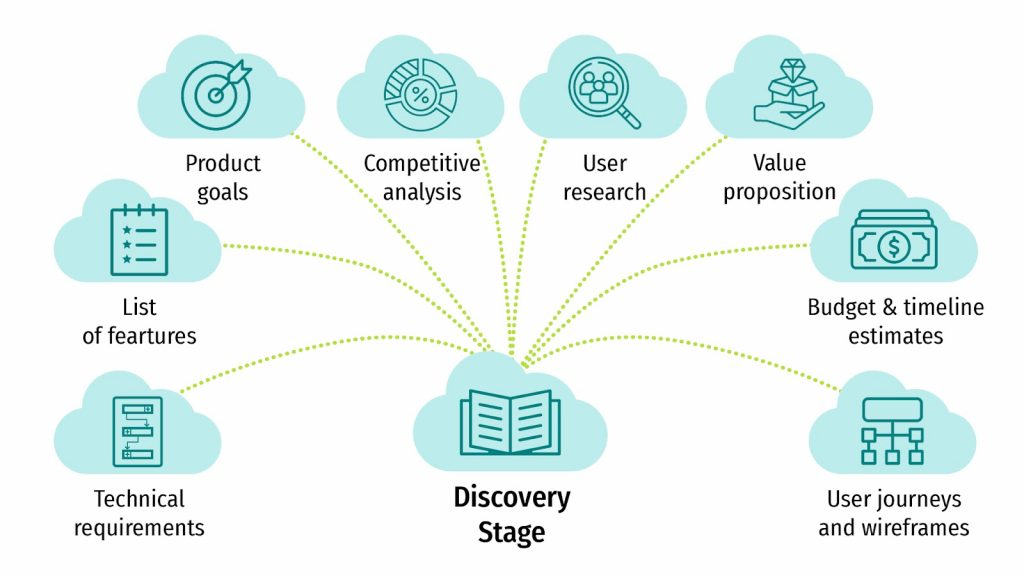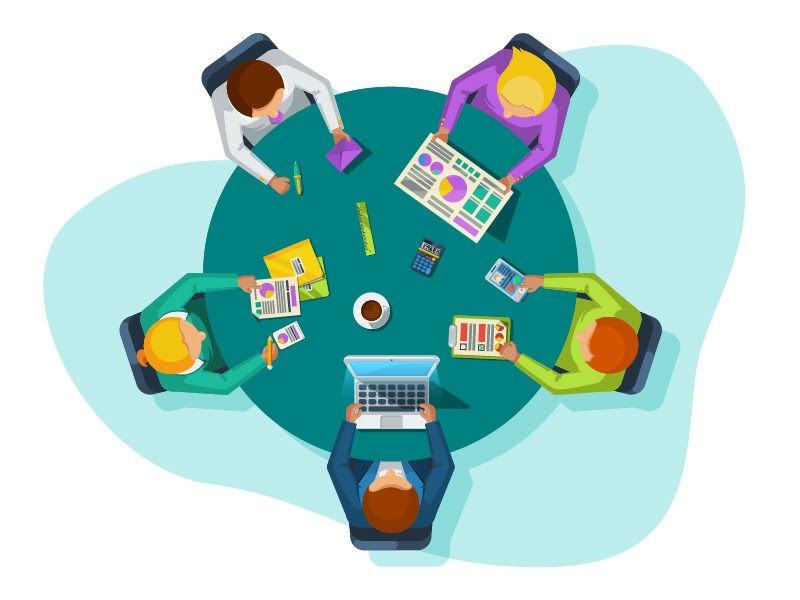“What is the discovery phase?”
“Why should I care about it?”
“What happens during the discovery phase?”
If you’ve been asking yourself these questions, then you’ve come to the right place. Many folks have to learn about the discovery phase before starting their software projects or tech startups.
And guess what—
Entrepreneurs who go through the discovery phase are glad they did so. The thing is, discovery reduces the risk of missed deadlines, budget creep, never-ending project scope changes, and many other problems.
So, the discovery phase can be your best friend. Read on to know how.
In this post:
- Discovery phase definition
- Importance of discovery for software projects
- Discovery phase stages in software products
- Risks of skipping the discovery stage
Let professionals help you with the discovery phase. Get a free consultation from our experts.
What Is The Discovery Phase?
The discovery phase is the first step in a project development process that focuses on collecting and analyzing information. The goal of the discovery phase is to allow stakeholders to develop a good understanding of the project, its goals, limitations, and target users.
In software development, the discovery phase is critical to find out the best solution for target users’ needs. Also, the client and the vendor decide on the timelines, budget, and resources, to create a plan for the entire project implementation.
Discovery phases for different projects may involve different stages. Let’s see an example. A project discovery phase for mobile app development can include these steps.

CAn important thing to mention—
The discovery phase is not the time to solve every problem.
It’s the time to validate your software idea and create a plan to deliver the product that people can actually use. The discovery phase lasts anywhere from one week to several months, depending on the project’s complexity.
Why Start Software Projects With The Discovery Phase?
So we know that the discovery phase is designed to reduce risks and help prepare for projects better. If you’re an early-stage software startup or a business owner who wants to build software, here’s why you need the discovery phase.
Reduce risks
During discovery, you and your software vendor get your hands dirty planning every aspect of the project. Budget, resources, talent, functionalities, requirements, competitors, you name it—everything is discussed, analyzed, and planned to bring clarity.
Thorough planning helps minimize many risks, including missed deadlines, budget creep and a lack of monetary and human resources. Both parties (you and the software vendor) play an important role, as their expertise helps discover all potential risks.
Make better decisions
Make decisions based on facts, not assumptions. That’s one of the main goals of the discovery phase in every project. For example, user research will provide the information you need to define the suite of features without any guesswork.
Besides, the decisions made during the discovery phase will also provide context for decisions that stakeholders will be making once the project starts. For example, a well-defined risk mitigation strategy will help choose the best strategy to address specific risks if they occur.
Set a vision and strategy
Refining the product vision and strategy is one of the most important goals of discovery. Since this phase requires doing your homework on creating a shared vision and project plan, you can get all stakeholders on the same page.
Skipping this step will make creating a shared vision and a strategy much more challenging. Software developers and business teams might not have the same understanding of the product, which could lead to misunderstandings about fundamental project goals.
Plan resources and budget better
Do you know how many software developers you need? Will there be some travel expenses involved? Or, what should the entire project budget be?
You probably don’t, and that’s totally fine. No one knows the exact amount and the nature of resources required to develop a specific piece of software. And they don’t have to speculate because project stakeholders plan everything during discovery.
Example:
A project manager—typically provided by a software vendor—will be helpful here. This person will collaborate with you to estimate the cost for the project as it relates to employee salary, the cost of applications they need, and others.
The role of a project manager also involves preparing the business case, coordinating communication, and finding ways to reduce risks.
Learn more: Role of Project Managers in App Development Projects
Make better, more user-focused products
The discovery phase is an opportunity for all stakeholders to understand the future product and its users better. By conducting user research, the team can understand the problems, needs, and interests of customers, along with underlying drivers and motivations.
One customer research tool at play here is a customer journey map. It’s a visual representation of the processes users will go through to achieve their goals with the product. Every map is based on user research and reflects their goals, needs, and problems.
Here’s a customer journey map example for a food delivery app.

Food delivery apps like Uber Eats generated $26.5 billion in revenue in 2020.
Here’s how to create a similar app if you’re thinking of this business idea: On-Demand Food Delivery App Development Process.
Discovery Phase Steps
As mentioned, the discovery phase may differ from product to product, depending on its complexity. But some steps are essential and apply to most software projects. Let’s go over these steps.
User research
Through user research, the team learns about the target customers, their needs, problems, and goals. Knowing this information is a must to design a great product with practical value for intended users.
Common user research techniques:
- Lab studies. Conducted with a mobile device in an environment where the research team can observe participants.
- Online surveys. These contain questions related to the product and are answered by a specific group of participants online.
- Stakeholder interviews. Any stakeholder who has the knowledge of the target customers can provide helpful information about them.
- Market research analysis. Most businesses learn about customers with various market studies, so analyzing them is a way to learn more insights.
Information collected during user research helps the team to go from assumption-based decisions to decisions guided by data and insights. This strategy increases the chance of creating a product that target users will love.
Goal setting
Having clarity on project resources, timelines, and the overall vision makes goal setting easier. That’s why the team that works on the project comes up with measurable goals and success criteria during the discovery phase.
The project manager ensures that the project meets the client’s business goals in terms of:
- Budget
- Time to market
- User experience
Once the project plan and business goals are aligned, the implementation can begin. Just like that, the discovery phase can help avoid scope creep and other problems.
Defining value proposition
Having analyzed user research and the functionality of the future project, the project team can define specific value propositions.
For example—
Here are the value propositions of the Airbnb app:
- For owners: list their space and earn money
- For travelers: easy access to renting private homes
- For travelers: opportunity to engage with locals with “Experiences”
Having clear values is the first step towards defining and prioritizing tasks for software developers.
Also—
We already know that customer journey maps are created during the discovery phase. They are also important here because they show how people will get the value.
Understanding the broader context
A thorough analysis of competitors, technical limitations, legal regulations, and other factors are also a part of the discovery stage.
Let’s go over some of them:
- Competitors. The team identifies the main competitors, their strategies, and ways to differentiate the future product from them.
- Legal regulations. Are there any laws or regulations impacting the product? Considering them is a must to ensure compliance with local laws.
- Technical limitations. Time zone differences, outdated management practices, compliance issues, and other problems are considered.
Understanding the broader context by using these factors will help prevent many issues down the line. For example, studying laws to ensure compliance is a way to prevent potential reworks for users in certain countries or states.
Agile is the best way to overcome technical limitations in software development projects. Learn more: What is Agile Methodology?
Can I Skip The Discovery Phase?
Skipping over the discovery phase can be tempting.
After all, the goal is to create a product as fast as possible. That’s why some businesses choose to go straight to product design, thinking it’s a way to hit the ground running.
But here’s what can happen in that case:
- Lack of value proposition
- Unnecessary product features
- Budget pressure and uncertainty.
- Forced product customizations or changes
- High risk of having to remake functionalities
Sounds like reasons why startups fail, agree?
That’s why we believe that skipping the discovery phase is a bad idea. Here, the saying “slow and steady wins the race” definitely makes sense.
Summary
The discovery phase matters. Period.
Skipping this important step can have a major effect on the entire project. The small initial time and money savings are likely to be overshadowed by potential underestimated resources, inaccurate budget, employee frustration, or reworks.
So, we strongly recommend you use discovery. This way, you’ll put your project on the right path and save a lot of resources. Having a professional team helping you is another way to minimize risks, so we invite you to contact us to discuss your software project.



